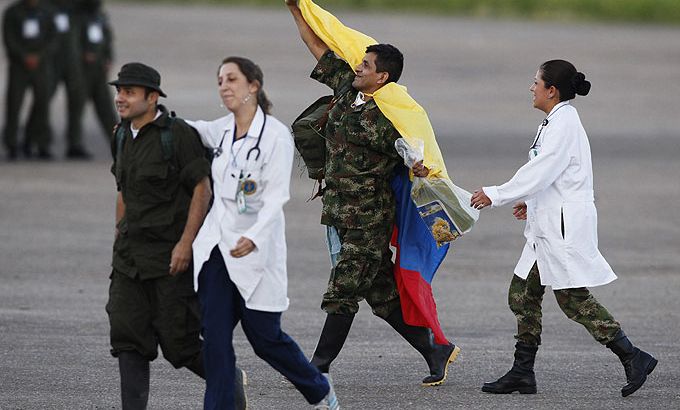
Is this the beginning of the end for FARC?
As the Colombian rebel group releases hostages, we ask if the end of Latin America’s longest running insurgency is near.
The Revolutionary Armed Forces of Colombia or FARC is calling it a gesture of peace: freeing the last 10 members of the armed forces and police they were holding hostage.
They were held captive for more than a decade in the jungle by the rebel group that has been involved in an armed insurgency against the Colombian government for five decades.
|
“The government is in the middle of its four-year period so [it] is thinking [of] elections in the next two years. Peace processes here in Colombia have been very messy so I don’t think that the president will want to undergo any peace process before he is re-elected, if he is re-elected …. And that is why he is playing down the releases this week.“ – Bernardo Perez Salazar, a researcher of Colombia’s armed conflict |
The left wing group says it represents the rural poor in a struggle against Colombia’s wealthier classes and opposes the influence of the US in Colombia.
The operation was not led by the Colombian government. It was brokered by the International Committee of the Red Cross and Colombians for Peace, an organisation that has long been critical of the government’s refusal to engage in peace talks with the FARC.
Al Jazeera’s Gabriel Elizondo, who was in Villavicencio, Colombia on Monday for the arrival of the released hostages, said: “Apparently wanting to downplay the outsiders’ role in the hostages’ release, the Colombian government barred family members from greeting their loved ones on the tarmac and, unlike previous hostage homecomings, prevented the media from filming the emotional first encounters with family.”
Thousands have been kidnapped for ransom during the course of the conflict. But in recent years, several of the FARC’s leaders have been killed and their fighters driven back into ever more remote regions as Colombian forces, backed by US military aid, mounted an offensive against the group.
The release of the 10 hostages, and an announcement in February that the group will no longer take hostages for ransom, could signal that the FARC is ready for a negotiated settlement to its struggle. But sceptics argue peace talks may merely be a ruse for the FARC to regroup and strengthen after recent losses.
|
“I think President Santos understands that there isn’t a military solution to this conflict, that ultimately this will end at the negotiating table …. He is going to move forward, but he’s going to be very cautious.“ – Marc Chernick, a professor of Latin American studies |
Juan Manuel Santos, the Colombian president, is demanding that the FARC free all of its remaining prisoners and cease attacks on civilian and military targets before any talks take place.
After the release, he said: “This liberation is part of a promise by FARC to no longer kidnap. It is a step in the right direction, a very important step. But, like we said when they made the initial announcement, I hope that more will be done. This promise is not sufficient. They have to free the kidnapped civilians that are still in their power. The country, the world in general reclaims the liberty of all of the kidnapped.”
But recent weeks have seen an intensification of fighting between the government and the rebels. And it is difficult to determine how many civilians are still held captive by the FARC.
So, will this latest hostage release lead to eventual peace talks and a negotiated settlement with the Colombian government? Could this be the beginning of the end of Latin America’s longest running insurgency, or will the FARC use it as an opportunity to strengthen its forces? What do the FARC want and do the conditions that led to the group taking up arms still exist?
Joining Inside Story Americas with Shihab Rattansi to discuss this are: Jim Jones, a development specialist who has worked in areas under FARC control and who has had contact with the FARC on several occasions; Bernardo Perez Salazar, a researcher of Colombia’s armed conflict and peace process with first-hand experience of dealing with FARC members over the management of natural resources; and Marc Chernick, the author of The FARC at the Negotiating Table and a professor of Latin American studies at Georgetown University.
| “The current conflict in its current phase is certainly an extension of conflict in Colombia historically. The FARC started out as a peasant insurgency … and much of that beginning is still with them, much of that agenda that is important to them is still there. And probably central to all that is the whole notion of rural development, agrarian reform. That has long been the centrepiece of the FARC and I think it is still very present. The guerillas out there who are fighting the conflict with the FARC are almost overwhelmingly from peasant families.”
Jim Jones, a development specialist |
FACTS: FARC KIDNAPPINGS
- In 2000, more than 2,100 people were kidnapped in total, although it is difficult to say how many of those were taken by the FARC as opposed to other groups
- In 2002, the FARC alone is said to have taken over 930 hostages
- Over the past decade, the number of kidnappings has dropped significantly
- By 2010, the FARC took just 64 hostages
- The number of actual civilian hostages still being held by the group may be just a handful